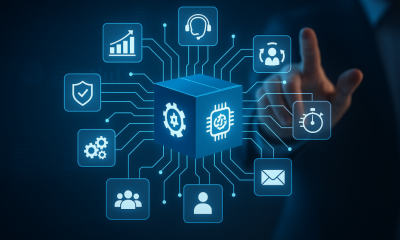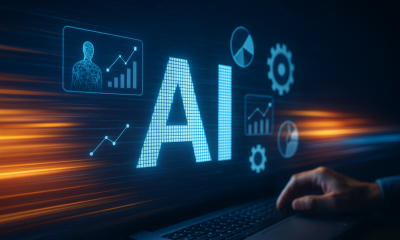Thought Leaders
Where to Start with Agentic AI: A Framework for Business Leaders

Over the past decade, two parallel journeys have emerged and shaped enterprise transformation in tandem: the process journey and the data journey.
The process journey, or how work gets done, evolved from Lean Sigma Six to encompass robotic process automation (RPA) and digital workflows, all in pursuit of efficiency, structure, and scale. On the other hand, the data journey, or how decisions get made, evolved from traditional business intelligence to machine learning-powered predictive intelligence and now, generative AI (gen AI). Both paths are powerful, but the true breakthrough comes when they both converge. Welcome, agentic AI.
Agentic AI is the inflection point where agents not only understand data but also know how to act within systems and workflows for greater data-driven automation. Research shows that 96% of enterprise IT leaders plan to increase their use of agents in the next 12 months. However, as organizations look to scale agentic AI initiatives, they often struggle with identifying where and how to begin.
For technical leaders looking to leverage agentic AI, they must think about agentic workflows as the fusion of decision and execution, embedding analytical intelligence directly into workflows for greater efficiency. Only when that enterprise-wide layer of intelligence is achieved will autonomous agents be able to close the loop between knowing and doing.
Defining agentic AI: what it means to be an agentic enterprise
Many organizations begin their agentic AI journey before they understand what agentic AI is. Think of an agentic enterprise as a busy international airport. The airplanes are the AI agents each tasked with an assignment. They know their goal and act on it independently, taking off and flying to their intended destination – all while the airport remains fully functional. But it’s the higher-level goal of the airport rather than the individual movement of planes that makes it agentic. The air traffic controllers are the orchestrators that make airport operations run smoothly – choosing which planes to deploy when and where, directing ground control for maintenance and refueling, and concerting it all in the most effective way for the entire system. Each plane exists on its own, but it’s the coordination of all take-offs and landings that make the airport successful in terms of safety and efficiency.
An agentic enterprise is not one that implements simple reflex agents, or basic bots that have been enhanced to perform a task. Rather, an agentic enterprise orchestrates a network of intelligent agents designed to handle complex, multi-step tasks independently. They go far beyond predefined rules to where agents can make decisions that align with strategic goals, and adapt and improve over time, taking enterprise learning to the next level.
This is also what separates agentic AI from gen AI. Gen AI responds to prompts, while agentic AI takes autonomous actions to achieve goals, learning and adapting as it goes. These multi-agent systems connect with various enterprise applications, and operate with strategic foresight to help drive decision-making, automate processes, and deliver value across the organization.
It’s important to remember that this is a journey. Each agent will have its own maturity and complexity it can handle. Becoming an agentic enterprise requires the holistic design, coordination, and continuous evolution of an ecosystem of agents, with clear goals, intelligent feedback loops, and expert humans embedded where and how it makes sense for the target outcome.
Identifying agentic AI use cases: why driving value matters
All too frequently, agentic AI use cases fail because of poor use case selection. In fact, Gartner predicts over 40% of agentic AI projects will be cancelled by the end of 2027. These won’t be from the technology failing, but rather enterprises not choosing the appropriate use cases to deploy the agents.
To avoid such a fate, organizations need to identify where agentic AI can have the greatest impact by assessing both the value uplift and speed to outcome.
On the value side, enterprises should first ask which domains hold the greatest customer pain points – internal and external – and in turn, have the most promise for impact. Then, they must consider what the process scope and demand look like. A hint? Agentic AI delivers more tangible benefits for areas that have highly complex processes, large workflows, and a need for strategic, dynamic decision-making. It’s not to be understated that agentic AI should be implemented in areas that hold high growth potential, considering its scalability and adaptability to shifting demand and volume over time.
Equally important is evaluating speed to value, which can be done by examining data for availability, quality, and governance. Simply put, better data leads to better AI performance. Regardless of where agentic AI is activated, providing safety guardrails is critical, especially when sensitive data is involved. To do so effectively, enterprises must factor in potential regulatory restraints that may impact adoption timelines. This is not an area to cut corners. Starting with human-in-the-loop systems helps ensure responsible and ethical implementation, which can later give enterprises more confidence in the autonomy of AI agents.
Building the agentic AI tech stack: how to achieve desired outcomes
Organizations ready to adopt agentic AI need to build the right technology infrastructure that enables scalability to grow, flexibility to integrate, and security to protect.
To get started, enterprise leaders must ensure that both structured and unstructured data are integrated within the same system to build a strong data foundation, which is critical for effective and sustainable adoption. Data accessibility and management are foundational to agentic AI. This step is also crucial for building task- and domain-specific language models.
Once the data foundation is set and language models are established, enterprises should leverage AI platforms, tools, and services to accelerate AI agent adoption and modularity. Beginning with a pilot in a controlled environment, organizations can train and deploy agents that execute specific tasks and deliver on business outcomes, ensuring human oversight and continuously monitoring performance through a control layer that aligns with business KPIs.
Leading the Way
Agentic AI represents a fundamental shift in the way businesses operate. Enterprises that emerge as winners will be those who use it as an opportunity to rethink their operating models and business practices from the ground up. The key is to experiment wisely and iterate, build and partner with intent, and then scale with confidence.












